In-Person Learning Plan Creates Adverse Learning Conditions
Plan Has a Disproportionate Negative Impact on Black and Hispanic Students
There are systemic racist inequities that affect which students can engage in remote learning in our public schools. By now most of us know that. However, what you may not know is that these racial inequities were made worse by Lori Lightfoot’s in-person learning plan.
“In-Person” in Name Only
There are students who show up to schools in-person, only to watch a teacher on a screen who’s instructing them from home. Two weeks ago, we had no idea how widespread this phenomenon was. Then we surveyed principals and asked several questions including, “How many of your in-person classrooms are led by a remote teacher? Their responses are as follows:

In Majority-white schools, 17% of in-person students have a remote teacher. The Majority-Hispanic school percentage is 35, and nearly half of Black students showed up to school in-person only to be subjected to more remote learning. If that were not bad enough--as shown in the graph below--seven percent of in-person classrooms had no certified teacher at all.
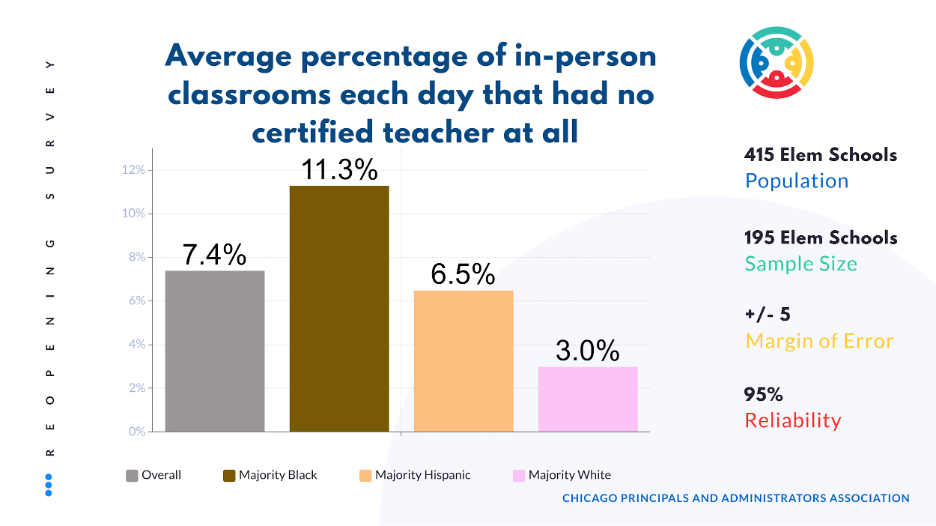
Three percent of classrooms at majority-white schools; seven percent of classrooms at majority-Hispanic schools, and eleven percent of classrooms at majority-Black schools had no in-person teacher and no remote teacher, due to staffing and substitute shortages. Respondents were given a chance to comment on their answers. Here are some of those comments:
“Not enough staff for coverage. Parents sent children to school and once they found out the teacher was remote, they opted to return to remote.”
“Staffing is the major issue. Being in school is proving to be no different than learning from home. My students are still sitting at a computer. It's just a different setting.”
“Unfortunately, we’ve had to hire non-certified teachers to supervise students while the teacher is working remotely on an accommodation plan. The lowest common denominator is having an adult in front of students.”
“I do not have the staff to cover classes for a teacher who took a leave at the last minute. Substitutes are not picking up the assignments. As the principal, I have been covering classes, supervising and escorting students to lunch; I have remote teachers taking personal days and I have to straddle, along with our AP.”
“I am fine with staffing if no one calls in sick or is absent. If one person calls in, then the whole system falls apart.”
“Our black and brown students will still suffer from lack of appropriate supervision when teachers are out. We know that help from the district will be minimal so we plan accordingly because we know much won't be given to our school.”
“The in-person learning challenges are the qualifications of the miscellaneous staff we use as classroom supervisors. Many are our parents. These individuals come to us without the skills of a teacher, like classroom management, computer skills, and basic content knowledge. Some are limited English speakers.”
“Miscellaneous staff attendance is unstable. So we have to find coverage for the coverage.”
“I can't keep a miscellaneous employee to save my life.”
Of the schools surveyed, the majority served Black or Hispanic students, while 19 of them served a majority white student population. Their responses exposed multiple adverse learning conditions, and all of these conditions were more likely in schools that serve Black and Hispanic communities. This is due primarily to the failure of the mayor and CPS to ensure those schools had the most important resource a school can have: an adequate number of qualified staff. Students go from watching a teacher on screen at home to watching a teacher on screen at school. That’s what Mayor Lightfoot gave Chicago, and the darker your skin, the more likely you are to be a victim of the mayor’s failure to listen to the experts on the ground.
The following comments are from a few of the principals whose schools have been able to manage because they have a better staffing situation.
“I'm VERY lucky at my school that so few staff qualified for ADA leaves and those who did were not core classroom teachers.”
“We are having great success with the hybrid model.”
“Our teachers are working hard and collaborating to ensure in-person students receive face-to-face instruction at some point during the day rather than be on the computer all day.”
While there is a stable staffing situation in some schools, the mayor didn’t open some schools. She opened all schools, and she did it while ignoring principals’ staffing concerns. As a result, instruction has suffered tremendously in most schools while principals scramble every day just to keep a warm body in front of students.
Teaching Multiple Grades at Once
Another problematic learning condition is having to sit in a classroom with a teacher who’s instructing multiple grade levels at once. That’s when a teacher has to teach eighth and seventh-grade students, for example, at the same time.
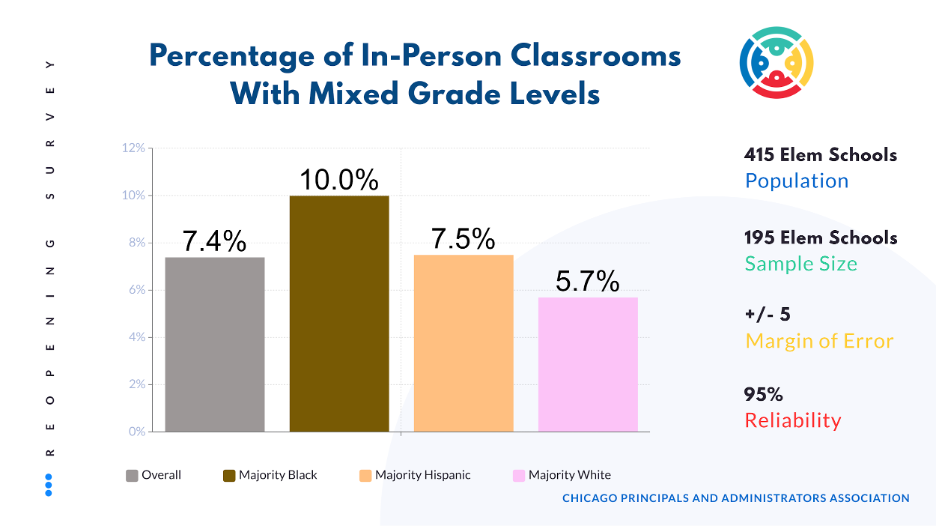
This happens in almost 6% of Majority-white schools, nearly 8% of majority-Hispanic schools, and 10% of Majority-Black schools.
Taught by Non-experts
Almost five percent of the districts’ classrooms are being taught by teachers who had to be reassigned outside their grade level or subject-area expertise due to staffing shortages. That means, for example, a second-grade teacher has to teach fourth grade or students get taught math by a social studies teacher.
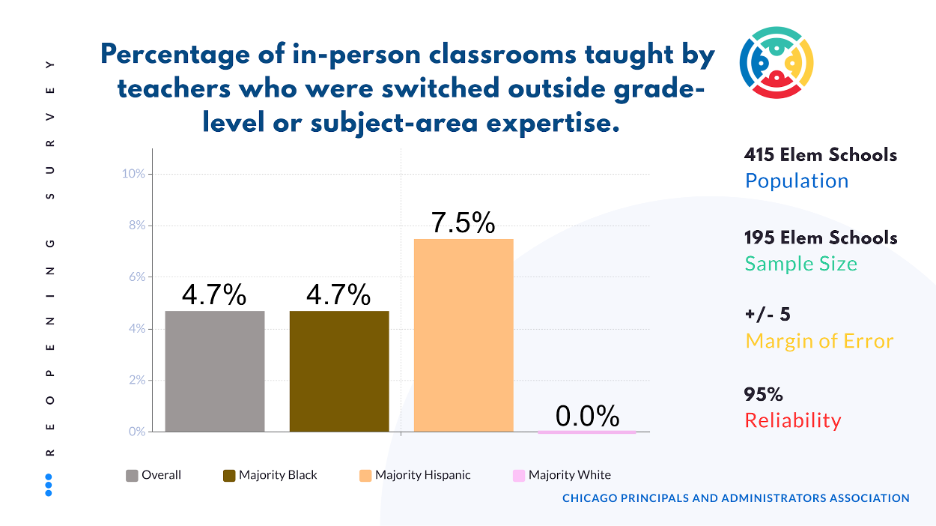
This is happening in nearly 5% of classrooms in majority-Black schools, nearly 8% of classrooms in Majority-Hispanic schools, but not at all in the classrooms of the 19 majority-white schools that responded to our survey.
No Recess
40% of students who participate in hybrid learning aren’t provided recess under Lightfoot’s reopening plan.
In majority-White schools, 29% don’t have recess. In majority-Hispanic schools, the number is 35%, and in majority-Black schools, 53% of students are denied recess due to the district’s failure to take staffing shortages seriously despite repeated warnings from principals.
Survey Comments
“The majority of the staff is tied to a classroom, making it difficult to provide recess.”
Summary of Adverse Learning Conditions
The mayor's failure to listen to principals’ concerns about adequate staffing has led to student in-person learning experiences that include no recess, teachers who are unfamiliar with the curriculum, two grade levels in one class, and in-person students with remote teachers or no teacher at all. Add to these adversities the fact that most teachers, whether they are remote or in-person, have to instruct in-person and remote students at the same time. These learning conditions degrade the quality of instruction and they’re all caused by staffing shortages.
Don’t Call Your Principal. Call Your Mayor.
Students who were most negatively impacted by remote learning are mostly from Black and Hispanic communities, and something needed to be done to help them. But principals warned the mayor repeatedly that students from those same communities will suffer disproportionately if the reopening is poorly planned, or inadequately staffed. Principals even proposed an alternative reopening plan to help the district avoid the racist inequitable scenario that we find ourselves in today. However, district management and city hall ignored the input of principals, and now thousands of students are subjected to learning conditions that are inferior to remote learning, and Black and Hispanic students are suffering the brunt of the consequences.
To be clear, there are teachers and other staff who have good reason to be remote. Our problem is that principals warned the mayor that she was making promises that most schools did not have the staff to deliver on. While ignoring principals’ warnings, Mayor Lightfoot and CEO Jackson used the trust that communities have in their principals to sell their ill-advised plan to the public. In doing so, they jeopardized the trust and relationships that principals have built with their school communities. One principal put it this way:
“They use our credibility to get buy-in from the community, but when the district’s plan fails, it will be my failure in the minds of my community. The district is telling us to send letters to parents about schedules that we cannot verify will happen. I’ve worked too hard to build community trust to squander it when they send their children to the class and there’s no teacher. I cannot sacrifice relationships I’ve worked so hard to build.”
So if your child showed up to school for an in-person learning experience only to end up in a class with a remote teacher, don’t call your principal; call your mayor. If your student spent an entire day in school with no recess, don’t send a complaint to your principal; complain to @chicagosmayor. And if your children were in remote learning with kids from the same grade levels, but now they’re in so-called in-person learning with students from two or three different grade levels, remember that principals warned the mayor and CEO this would happen. So thank your principal, and call your mayor!
A Talking Point and a Photo Op
After citing racial inequities to justify her push to reopen schools, We found it odd that Mayor LiIghtfoot chose to have a reopening day press event in a majority-white elementary school. Once we saw the data on these adverse learning conditions in majority-Black and Hispanic schools we began to understand why she kept the press away from them. There's a chance a reporter could have taken his camera by one of those classrooms where students are either looking at their teacher on a screen or don’t have a teacher at all, and that’s not the story she wants in the news.
I hope that Mayor Lightfoot and CPS CEO Janice Jackson are given a chance to respond to these findings and share their own data about adverse learning conditions. Odds are, however, that they don’t have the data because they didn’t bother to ask these questions. The mayor got her reopening photo op and her campaign talking point, and now it’s time to divert the public's attention away from the poor learning conditions this plan created in schools across the city; especially the schools that serve Black and Hispanic students. Her goal was a headline, a photo op, and a campaign talking point: “Just remember folks, we reopened schools. Now move along. Nothing to see here.”
The Needed Questions
Our Children/students are more than a headline, a photo op, or a talking point. The learning experience all of our students deserve requires a different set of questions. It requires the input and expertise of building administrators and for this to happen, the public and the press have to ask specific questions and demand specific answers.
- What percentage of in-person students are learning from a remote teacher?
- What percentage of students can’t have recess because of staffing issues?
- What percentage of classrooms went unstaffed due to substitute problems?
- What percentage of classrooms have mixed grade levels?
- Were there any groups that suffered these adverse learning conditions more than others?
These are the questions that the mayor and CEO must face.
The following graphs highlight other data points that need to be addressed:

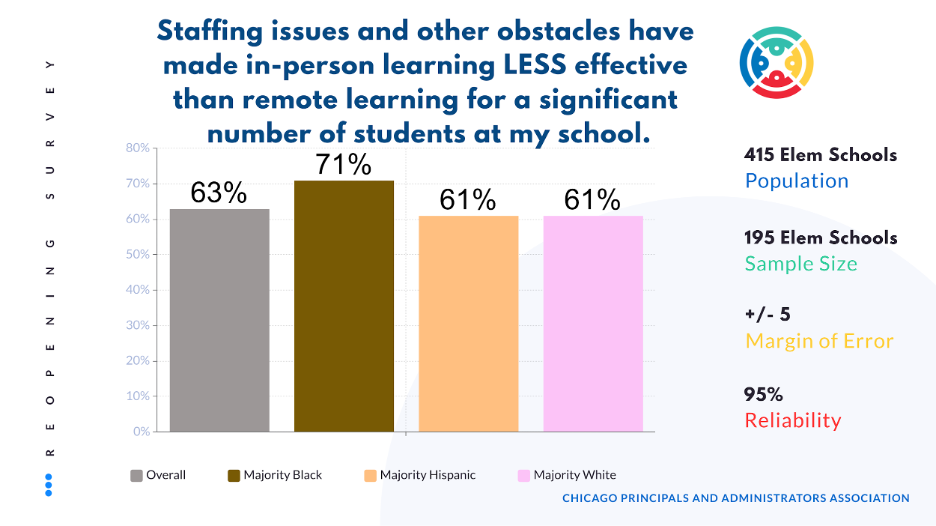
Given the greater prevalence of adverse learning conditions in majority Black and Hispanic schools, the high number of principals at majority-white schools who indicated in-person learning was less effective initially came as a surprise. When we ran these results by a group of 25 CPAA members they believed the high degree of principals who said CPS’s version of in-person learning was less effective than remote learning was due to an adverse learning condition that our survey did not ask about: simultaneous teaching. Even though teachers at majority-white schools were more likely to teach in-person, they still have to teach remote and in-person students simultaneously, which has a negative impact on the quality of instruction for in-person students. So while several of these detrimental learning conditions make in-person learning less effective in many majority Black schools, this one condition (simultaneous teaching) makes hybrid in-person instruction less effective in all schools.
Since the above question used the word “significant number” we asked principals to tell us what percentage of students represented a “significant” number.

Survey Comments
“Simultaneous instruction is not yet effective. Teachers are struggling to target students in-person and remotely. Students are not getting quality instruction. “
“Though we have been given so much technology, we are still short of what we really need. Smart panels really help connect remote and in-person learners, and we do not have them in every classroom. So from class to class, the quality varies from this alone.”
“Instruction is so much poorer.”
“The in-person teacher covering the in-person students also has remote students. So, as a practical matter, even in-person students with an in-person teacher are learning remotely.”
“We have too few students, so planning is still geared primarily towards remote learners with in-person learners getting the same instruction but from the school rather than their homes.”
“Having so many students remain remote and so few in-person negatively affects the simultaneous teaching. It is probably the most challenging issue we are faced with right now.”

The fact that only 39% of principals of majority-Black schools felt they had adequate staff is even more concerning when we look at the results from our follow-up to this question, which was to indicate whether they agreed or disagreed with the statement, “If more students show up to -in-person learning, I will not have enough staff to keep everyone safe and implement an effective instructional program.”
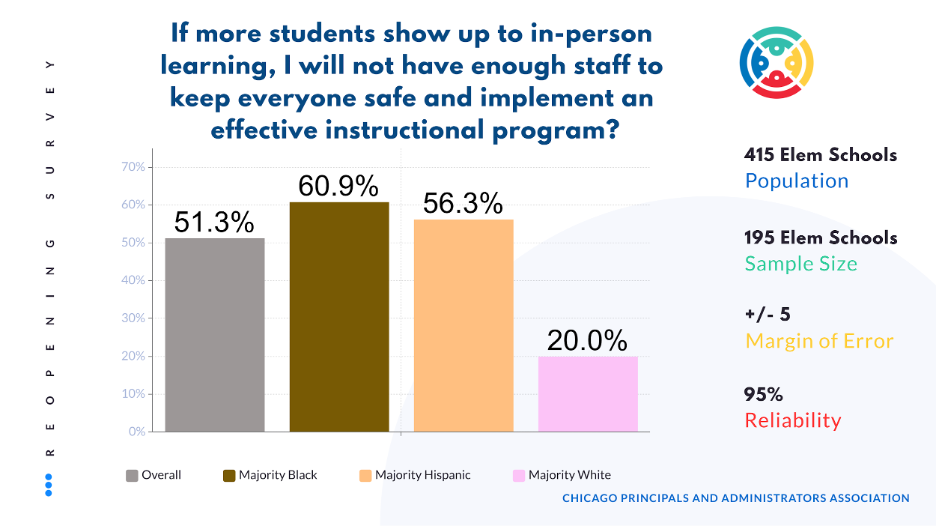
The fact that only 39% of principals of majority-Black schools felt they had adequate staff is even more concerning when we look at the results from our follow-up to this question, which was to indicate whether they agreed or disagreed with the statement, “If more students show up to -in-person learning, I will not have enough staff to keep everyone safe and implement an effective instructional program.”
These responses indicate that the only reason many of those principals from majority-Black and majority-Hispanic schools indicated they had enough staff in response to the previous question is that so few students are attending in-person learning at their schools. The following survey comments are illustrative:
“We do not have that many students that returned to in-person learning, so it has been pretty easy to divide the students into classrooms and a single pod.”
“Due to the low number of student attendance, we have an effective entry and exit plan that allows for social distancing.”
“Though we would much rather have our students come to school, we are fortunate that so few elected to come to school. We would not otherwise have the capacity to cover classrooms.”
“The rolling approvals of ADA accommodations and the number of SECAS that had to be moved. If these staff members are not called back in the 4th quarter and we have an increase in students, we will not be able to pull it off as we are now.”
What We Need
Mayor Lightfoot needs to allow the education experts--Chicago’s principals--to develop their own reopening plans that work for their schools. To be clear, this does not mean giving principals the “flexibility” to figure out how to implement the Mayor’s plan. This means letting principals scrap Lightfoot’s instructional debacle and come together to create plans of their own to match the staffing and resources available to them. It also means focusing the district’s personnel resources on the schools with the most adverse learning conditions to help them develop and implement in-person plans that are more ambitious and effective than what their current staffing and resource levels would allow.
Call to Action: Demand Chicago’s Mayor Honor Her Word
Black and Hispanic students are still suffering under Lori Lightfoot’s half-baked in-person learning plan. When a mayor or school board creates a policy, the people who have to implement that policy in schools are principals. As a result, principals have insights that no other group has. This racist instructional debacle could have been avoided if Mayor Lightfoot had simply listened to principals and taken our warnings seriously. Follow this link to sign our petition to demand that Mayor Lightfoot do what she said she’d do when she was running for Mayor:
“Principals have to be at the table. Principals play an incredibly important role. Some would say the most important role … and I’m going to go in the first instance through the agent who’s responsible for being the voice and advocate for principals.”
Since becoming mayor, Lightfoot and her appointees at CPS have defaulted on her campaign commitment and attempted to ignore the elected representatives of principals. CPS students have suffered as a result. So sign our petition today to demand that the mayor and her appointed leadership at CPS consult with the elected representatives of the Chicago Principals and Administrators Association in all phases of the design and implementation of district policies and initiatives, especially when those initiatives and policies rely on principals, their talent, expertise and relationships to implement them and make them successful.

